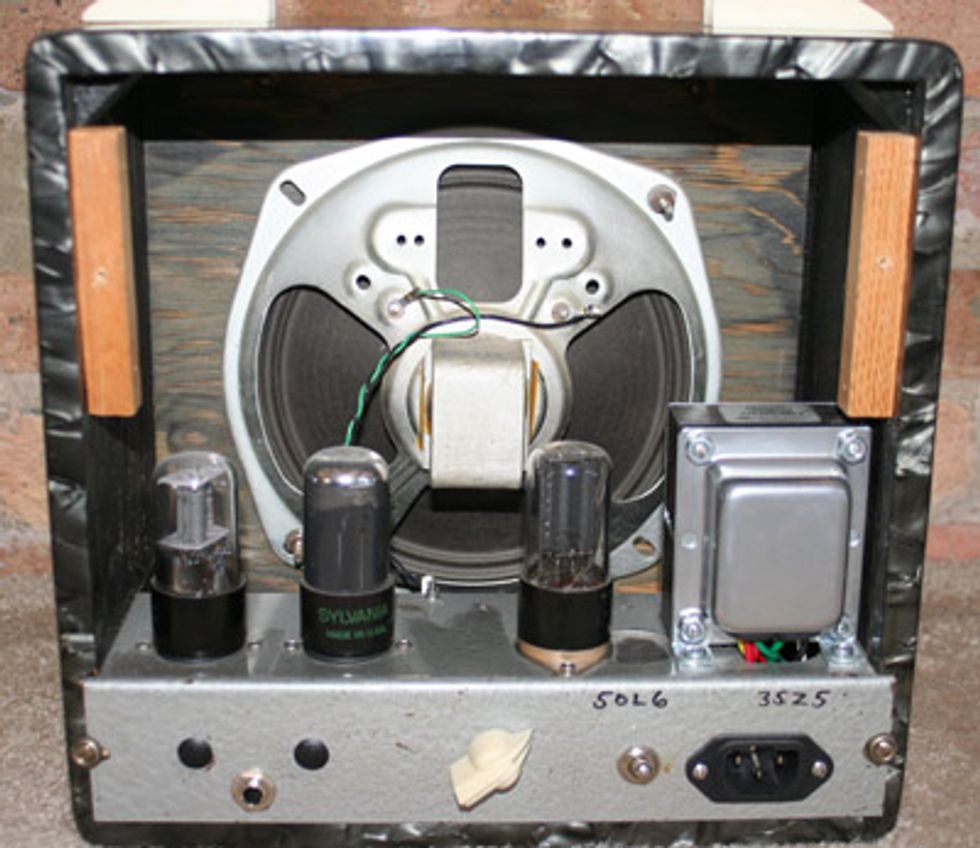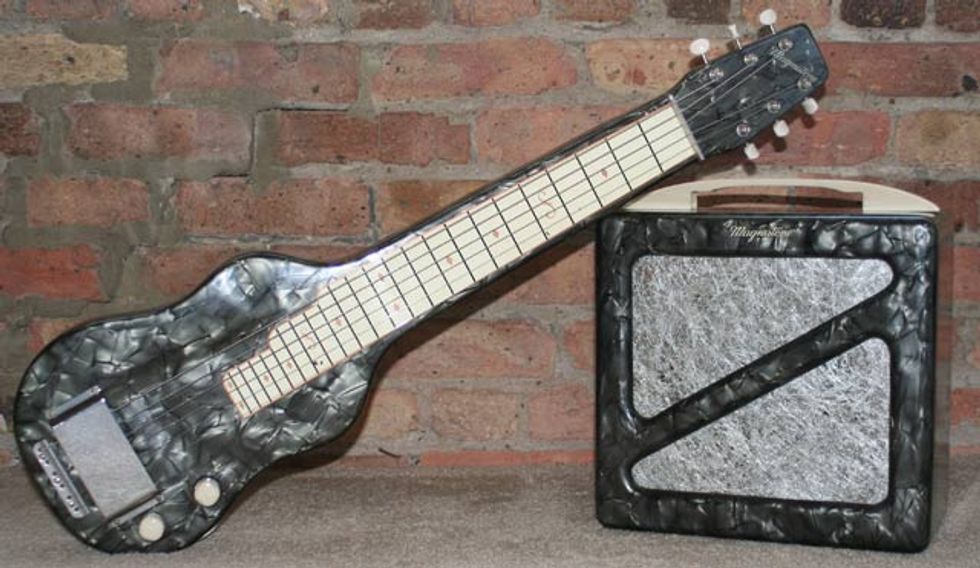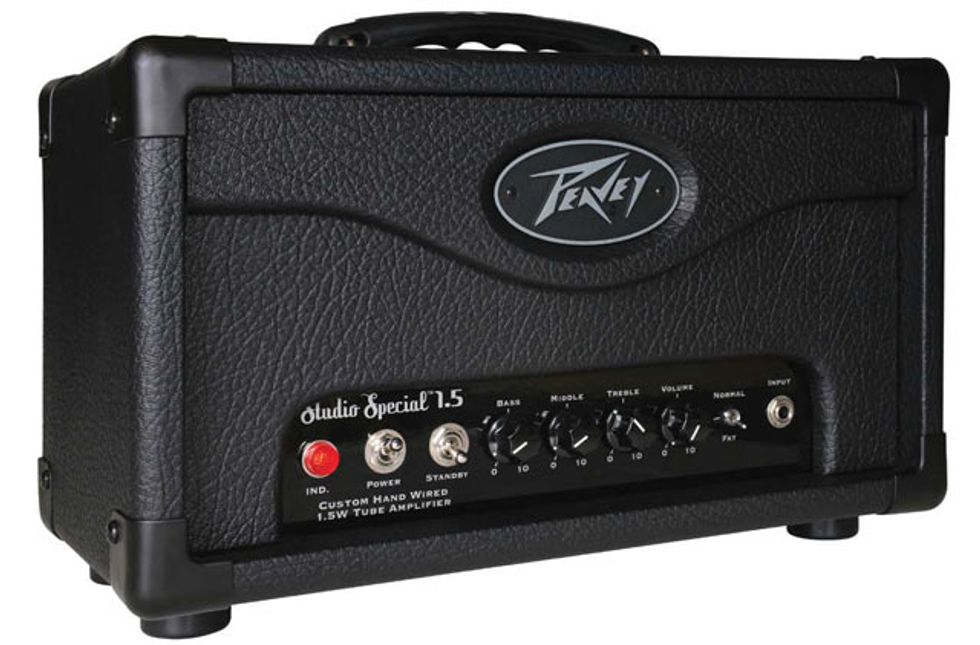When Tim runs into a dangerous power situation in an old Magnatone lap steel amp, he''s tasked with completely reimagining the project.
It seems as if almost all of our clients have at one time or another, purchased something online. Often a funky old guitar or amp that was acquired at, what seemed to be at the time, a decent price. We hear the same words uttered over and over again. I just got an amazing deal on this at e…(rhymes with hey) but I think it needs a bit of work. Often, the amount of work required to transform the instrument into something playable makes the “great deal” now seem like a thorough hosing. Sometimes items come with a trial period in which the buyer can return it if doesn’t meet his/her expectations. Other times the piece may be salvaged or kept, though unusable, simply because it has a certain amount of character that makes it worth having if only for a wall hanger.
This month we’ll be taking a look at one such project. It involves a Magnatone lap steel and amp set.
A client purchased a beautiful (and very early) Magnatone lap steel and amp set. They were brought into our shop to have a basic “check and clean” done to the amp and to have the lap steel repaired/restored. The lap steel needed to have the tuning machines replaced as the buttons had deteriorated to the point that they were now little ratty stubs that needed a pair of pliers to aid in the tuning process. A similarly styled set of Tone Pros 3-on-a-strip tuners were installed, scratchy pots were salvaged with a bit of electronics cleaner and some minor setup work was done to level the string heights at the nut.
The amplifier was powered on to see if it was working and to listen for any nasty noises that would need to be addressed in our “check and clean” procedure. Surprisingly, the amp sounded pretty darn good. It had a very unique character to the break up as the amp was pushed into distortion. The amp was then disassembled to check for leaky caps and resistors that may have drifted out of spec that would cause the voltages to swing to unsafe/improper levels. First I tried to locate the power transformer to get my bearings. Hmmmm, strange I thought, no power transformer! Then it dawned on me. This amp is running on pure AC!
While this isn’t that unusual in very early amps and it certainly contributes to its unique tone, it’s also very dangerous. One leg of the AC is tied to the chassis as a buss in the same way a ground would be in a more modern design. This would almost be okay if the instrument being played through it had the strings isolated from the electronics (though it's still present on the metal chassis). However, in most modern guitars, the strings are attached to the ground. In this instance it means that the player now has one leg of the AC on his/her strings! This puts me in a rather precarious position. As the tech and owner of the shop, there are some obvious liability issues associated with this project.
The client was consulted and told of the dangers that lurked within this design. As he loved the look and character of the box, he gave me the go ahead to build a simple and more “modern” (late-'50s) design into the existing chassis. A promising schematic was found (a Valco of some sort) that used a 6SL7 octal preamp tube a 6V6 and a 5Y3 rectifier. This design was chosen simply because of its funky character, which was thought to be in keeping with the original design.
It’s freeing being charged with the task of simply making something funky that works. Certain liberties can be taken in component selection that wouldn’t necessarily be considered when shooting for a dead silent recording amp or a rock solid touring amp for example. I was able to use some really neat Soviet-era paper in oil caps that I found while traveling in Bulgaria last year as well as some interesting carbon comp resistors acquired at the same time. Fortunately, the original speaker was still in good shape and was reused.
Mission accomplished. The end result was a marriage between over-the-top vintage form and functionality. The amp was transformed into a safe and usable conversation piece and I’m told, gets many hours of use a week. While this project may not have been the most economical way to go about getting a small practice amp, it did end up salvaging a very cool set and making it safe and enjoyable for the proud and happy owner.
An Ampeg B-15-N without a speaker plug
I recently acquired a ‘60s Ampeg bass amp. It says B-15-N on the top of the chassis. It’s in really nice shape, but the problem I have is the plug for the speaker cabinet is missing and I don’t know how to wire on a new plug. Can you help?
Thanks.
John
Hi John,
Very cool amp you have there. Those amps definitely do sound great and make a great recording tool in the studio. They’re known as Portaflex bass amps and countless bass tracks in the ‘60s and ‘70s were recorded with them. If you’re a fan of the Motown sound, you’re listening to the bass grooves of a Portaflex. Besides being a Motown fan, the other cool factor that these amps have for me is that this generation of Ampeg amps was manufactured in my home town of Linden, NJ. The Ampeg factory was also stomping grounds for some other notables in our industry, such as Ken Fischer (Trainwreck Amps) and Denny Kager (Sundown Amps). But I digress. On to your question.
Over the years, the amplifier to speaker connection on Portaflex amps was accomplished in a few different ways. Early Portaflex models used an octal plug and socket pair, similar to the base of an 8-pin tube (like a 6L6) and the socket it plugs into. I’ve even seen a very early model where the speaker connection was accomplished with the bolts and clasps used to secure the flip-top chassis to the speaker cabinet. While I can’t remember if I believed this to be a stock factory configuration at the time, I don’t think it’s a very reliable method. The later models, which seem to be the majority of the Portaflexes in existence today, use a 4-pin XLR plug and socket. This is the style connector I’ll be referring to, and should be easily identified by a 4-pin male XLR connector attached to the side of the speaker enclosure. You will, of course, need to source a 4-pin female XLR connector for the end of your speaker cable.
To verify that your cabinet is wired properly, look inside at the XLR connector mounted to the side of the enclosure. You should see the two speaker wires connected to pins 1 and 4 of the connector. Pins 2 and 3 should be shorted together (more on the need for this later). If this looks okay, next look at the cable coming from the chassis. There should be four wires inside the cable. If this is all good, you’re ready to attach the connector.
Strip and tin all four conductors of the cable. Looking at the rear of the cable mounted XLR connector you are about attach, you should see pins marked 1, 2, 3 and 4. Connect the green wire to pin 1. This is the positive lead from the output transformer which connects to the positive side of the speaker. Connect the black wire to pin 4. This will serve as the connection for the negative side of the speaker. Connect the white wire to pin 3. This is connected to the circuit ground of the amplifier. Lastly, connect the red wire to pin 2. This wire is actually part of a safety feature designed into the amp—and is the reason that pins 2 and 3 are shorted together on the cabinet connector. One of the most damaging things you can subject a tube amp to is attempting to play it without a load (no speaker connected to it). In order to keep this from happening, the Ampeg Portaflex amps (as well as some others, including the early B25s and SVTs) had a built-in safety feature that would prevent the amp from having any output unless the speaker cable was plugged into its proper speaker cabinet. This was accomplished in a couple of different ways.
In your amp, when the plug was inserted, the shorted pins would connect the cathode resistor of the phase inverter to ground, enabling the phase inverter, which was then able to drive the output tubes. This was probably deemed a bit safer than its design predecessor, in which the connector furnished a ground connection to the center tap of the high-voltage winding of the mains transformer. I guess it just seemed safer to be switching the low voltage connection in the phase inverter than the high voltage connection in the power supply—but where is the adventure in that?
Anyway, now you know how to get your Portaflex up and running. With any luck, the speaker is in good shape, and all it may require is a bit of maintenance and possibly a new set of tubes. Hopefully, it still has the cool Plexiglas light-up Ampeg logo. You could find someone to engrave your initials in it as players used to do “back in the day.” Now go lay down some low down.
‘Till next time…
Co-Founder and Senior Design Engineer Budda Amplification jeffb@budda.com or www.budda.com.
Peavey dives into the low-wattage boutique market with signature affordability
When I first received the box containing the new Peavey Studio Special, I thought there was some kind of mistake. I was originally informed that a new amplifier from the Peavey Custom Shop was being sent to me for review, yet I thought the box was too small and too light to be an amp. I figured maybe I was sent something else, like an effects unit. I opened the box and to my surprise and amazement, it was indeed the Peavey amp!
Peavey is expanding its USA-based, award-winning Peavey 19th Street Custom Shop to include custom-built amplifiers. This series of amps are built to spec, based on point-to-point, handwired models, and they range from a single watt to a 50-watt, in a head or combo configuration. The first three to be unveiled are the Masterpiece, the Sensation and the one I just received— the Studio Special.
Small Package
The new 1.5-watt amp is ideal for recording studios and small rooms, and is available as a head only. The Studio Special allows players to achieve those “cranked up” amp tones, but at a decent volume level that won’t annoy your neighbors or loved ones. It is a straightforward, single-channel design with controls for Volume, Treble, Middle and Bass. There is also a Fat switch to boost the midrange. The warm and fuzzy distortion appears courtesy of two 12AX7 preamp tubes, and one 12AU7 tube in the output stage, which is configured in Class AB (a 6CG7 output configuration is optional).Download Example 1
British Rock tone - Charvel neck pickup. Setting on Amp: Bass – 10, Middle – 5, Treble – 7, Master Volume – 10, Amp Switch set to NormalDownload Example 2
Bluesy Rock Tone - Charvel neck pickup. Setting on Amp : Bass – 10, Middle – 4, Treble – 7, Master Volume – 5, Amp Switch set to NormalDownload Example 3
Funk Tone - Charvel neck pickup. Setting on Amp : Bass – 6, Middle – 10, Treble – 3, Master Volume – 3, Amp Switch set to Fat Download Example 4
Funky Blues tone with Single Coil pickup - Single Coil neck pickup on Fender VG Strat. Setting on Amp : Bass – 5, Middle – 5, Treble – 5, Master Volume – 5, Amp Switch set to FatDownload Example 5
Alternative Rock Tone - Charvel bridge pickup. Setting on Amp : Bass – 10, Middle – 2, Treble – 6, Master Volume – 10, Amp Switch set to FatUnless otherwise noted, all clips were recorded with a Charvel So-Cal guitar with Seymour Duncan pickups into the Peavey Studio Special into a Peavey Windsor cab and mic’d with a Shure SM57. The mic signal went directly into Digidesign Pro Tools.
It’s a fairly small amp, measuring only 8”x16”x8”. With an amp as straight-forward as this one, you definitely don’t need a bigger box. Besides the controls, there is one input, one speaker output and a power switch—it can’t get any more basic that that. Since this is from the Custom Shop, you can choose from a variety of Tolex covers to really personalize your amp.
Good Stuff
This little amp has been referred to as “Billy Gibbons in a box,” so I was looking forward to plugging it in and firing it up. I naturally hooked it up to a Peavey Windsor speaker cabinet first and was quickly surrounded by warm, smooth tube distortion and plenty of gain with my Charvel So-Cal guitar. You won’t find clean headroom on this amp, but you’ll definitely want to crank this amp up to 10 and rock out with it! It’s easy to achieve a variety of rock tones with only the three parameters you have to work with—everything from that warm British tube tone to fizzy, gritty fuzz. The distorted tones stay nice and tight when you crank up the power section. There is plenty of gain to please every player, except for maybe the extreme metal guitarist, who will definitely want to add an extra distortion pedal to the mix to achieve that high-gain tone they’re looking for.
I then plugged in my Strat, put the pickup in the neck position and dialed all the knobs to 12 o’clock. It was a thick, warm tone and great for bringing out those bluesy, single-coil sounds. When switching from Normal to Fat on the amp, it kicked in extra gain that was great for soloing.
The Final Mojo
It’s definitely a great amp for recording, and I found it to be really responsive and dynamic. In a live situation, the amp may be hard to hear over a loud drummer and would probably need to be mic’d to be heard properly. But it is called a Studio Special after all, so that’s where this amp will really shine. With Peavey’s 44 years of amplifier design and building experience, it seems only natural that they would now offer amps through their Custom Shop that buyers can design themselves. Different components and cosmetics can be custom designed from preselected options, or they can be specified on a per-project basis. Take a small amp that can be customized, add in Peavey’s reputation for producing reliable, great-sounding amps, and you have a winning combination with the Studio Special.
Buy if...
you'd like a USA-made handwired custom amp that won't take up a lot of space.
Skip if...
you prefer a combo amp with more than one channel for recording and practicing.
Rating...
Street $1000 - Peavey Custom Shop - peaveycustomshop.com |

